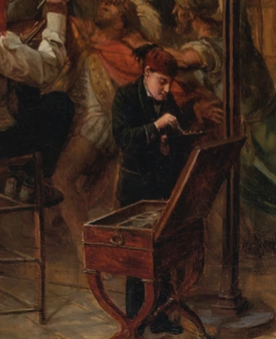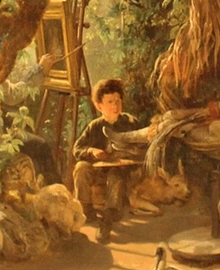Biard or not Biard, that is the question !
- Baptiste Henriot

- 23 sept. 2022
- 7 min de lecture
“ Biard is not an important enough artist to have been copied ! ”
How many times have I heard this sentence in the mouth of collectors to whom I had just announced that the canvas they had at home was a copy, or simply in the style of. I can certainly understand that this kind of news can disappoint, even upset, but there are limits to asserting that Biard was a minor painter and that he did not deserve the interest of his contemporaries.
In almost 70 years of career, Biard has produced a lot. Nowadays, more than 350 painted works have been cataloged, not counting the approximately 2 500 drawings and sketches brought back from various trips and which, for the most part, are today unlocated. Moreover, it is easy to multiply the number of his paintings when we know that Biard had the (unfortunate?) habit of making several versions of the same canvas. Why ? Nothing is certain, but depending on the dimensions of the work, it was most likely to allow him to sell more. If his favorite format is generally the one he exhibits at the Salons (100 x 130 cm or 130 x 160 cm), he often happens to use the same composition in smaller sizes (50 x 60 cm approximately). It is therefore not uncommon to unearth two or even three times the same painting at different scales. Also, we regularly find identical scenes or people in several drawings and paintings. This is particularly the case of his studies brought back from the Far North or from the Mediterranean, which he takes up on numerous occasions to imagine new intrigues.
Left : François-Auguste Biard, Sultana in an interior / Sultane dans un intérieur, oil on canvas, 1835,
65 x 54 cm, collection of the Sainte-Croix museum in Poitier
Middle left : François-Auguste Biard, Georgian on the terrace of the seraglio / Géorgienne sur la terrasse du sérail, oil on canvas, ca. 1835, 52 x 40,5 cm, collection of the museum of Art, History and Archeology of Évreux
Middle right : Zulicka, the bride of Abydos / Zulicka, la fiancée d'Abydos, engraving after Biard, ca. 1837,
Right : François-Auguste Biard, Saz player / Le joueur de Saz, watercolor on paper, 1828,
26 x 21 cm, private collection
It also happens to him, a few years after a first version, to change certain details, to add elements or to remove some, in order to be in phase with his own temporality. These corrections can be the fruit of his personal desire, but can also intervene at the request of a collector who is a little too fussy. You can find, for example, the transcription of a letter explaining this process in this article which deals with his project of leaving for a last great trip - a project unfortunately remained in the state of fantasy.

To help us in this work of attribution of his works, Biard had the good idea to sign nearly 90% of his production which, let's admit it, greatly facilitates the matter. This signature is quite easy to recognize because it is elegant, slender, fast and relatively regular. Nevertheless, it sometimes happens to come across a calligraphy or a gesture that is not in line with those usually visible. It is therefore quite natural to wonder if copies or pastiches could have been made, from the 19th century.
To cut short all suspense and speculation, the answer is yes, there are!
Not to mention falsely attributed canvases such as many unsigned burlesque scenes in "Biard-style" which are sold from time to time at public auctions ; it occasionally happens to come across a more than dubious signature, accompanied by generally weak and clumsy graphic writing, all suggesting that it could be the brushes of a completely different person. If, for the moment, no forger as such has really been identified, it is increasingly conceivable and plausible that Biard had extra hands in his workshop.
We know that Biard was always accompanied by his old friend Mouniss - a monkey adopted on the coasts of Africa - and that the latter sometimes had fun “ taking paint brushes, climbing on a chair , to hoist oneself in front of an easel and make paintings, glorious heaps of colors between-shocked and amazed to meet one next to the other ” (1). Is that enough to consider him an assistant ? Probably not, but it is possible that Biard had pupils and that, wanting to imitate the hand of their master with a little too much fidelity, they pushed the vice so far as to falsify his signature. This idea is not disconcerting and is based on two elements.
First, it happened that Biard represented himself in his paintings and, on several occasions, we can see young people by his side painting or drawing. Secondly, a press article clearly indicates that he had opened his studio in order to teach the basics of painting to a few apprentices.
“ We want to give space to a short story well done to interest people who do more than sometimes stroll around the Louvre - those who do a little bit of painting. M. Biard, that man of so much verve and so much wit, that brilliant, coquettish, easy brush, who plays with the most piquant episodes of bourgeois and vulgar life, and with the most horrible dramas in history , wars and massacres, adventures of all kinds, the unfortunate who die buried in the snows of the pole and the castaways abandoned to the fury of the cannibals of Polynesia. Mr. Biard has just opened a student workshop in his delightful museum in Place Vendôme. Mr. Biard, by the kind and flexibility of his talent, cannot fail to see the most elegant pupils rushing to his witty lessons, Mrs. Biard giving to this kind of practical course of the art, a very particular attraction by the grace perfect, the exquisite amenity with which she knows how to bring happiness to these charming reunions. ” (2)
Left : François-Auguste Biard, The Classical painter taking himself as a model, / Le Peintre classique se prenant pour modèle, detail, oil on canvas, 1882, 46,5 x 61,5 cm, collection particulière
Right : François-Auguste Biard, My Workshop / Mon atelier, detail, oil on canvas, 1866,
29 x 36 cm, collection of the Widener University Art Gallery, Chester
What is really strange is to have no artist having exhibited at the Salons and mentioned as being a “ student of Biard ”. Although I remain firmly convinced that these “ suspicious ” signatures come from this hypothesis. This question remains open for the moment until new evidence is found. In the meantime, these painters continue to be cataloged as mere “followers of”.

Now what about copies ? Some are quite easy to identify because sometimes they are simply annotated “ after Biard ”. This is the case, for example, of a Bivouac Scene in the Desert / Scène de Bivouac dans le désert which went up for sale in Antibes in 2021 and which was quite simply a copy by an unknown artist of a painting by Biard exhibited at the Salon of 1838.
Others are more difficult to detect because they are not annotated and you have to know perfectly Biard's work to spot them !
To illustrate this, let's look at a painting sold at auction in early 2022 (see photo below). The copyist is a certain Jean-Baptiste Alexandre Theuvenot, born on February 2, 1834 in Port-sur-Saône and died on December 2, 1882 in Paris. He was a student of Charles Gleyre and Léon-Jean Gérôme and, if he was a professor of graphic design and imitation at the colleges of Rennes and Laval, he was mainly known for his genre paintings and birds. Cataloged as an original work by Theuvenot, this canvas dated and located P.s.Saône 1852, is in fact an almost perfect copy of a painting by Biard painted around 1833 and now in the Musée des Beaux-Arts in Rouen. It represents a fairly popular subject in the first part of the 19th century : madness.
Left : François-Auguste Biard, The Madman's hospital / L’Hôpital des fous, oil on canvas, ca. 1833,
48 x 59 cm, collection of the museum of Fine Arts of Rouen
Right : Alexandre Jean-Baptiste Theuvenot, The Madman's hospital / L’Hôpital des fous, oil on canvas after Biard, 1852, 47 x 60 cm, private collection
At the beginning of his life as an artist, Biard was inspired by Théodore Géricault and went out into the streets to draw beggars, madmen and social outcasts. These issues and this in situ practice then allow him to emancipate himself from the influence of the Lyon school, to gradually focus on a certain quasi-ethnological realism. We recognize here the courtyard of the Antiquaille hospital, in Lyon, where a poor woman suffering from dementia can no longer even recognize her own family.
" The subject of this panting is not one that should be painted, but admitting its datum, we find the main group to be thrillingly interesting : on one side, the poor girl whose wandering eye does not no longer recognizes his mother who calls her on her knees ; on the other, her young sister who cries at the sight of such a spectacle ; in the background, the father whose altered features are imbued with a calmer but no less profound pain, and who seems to be questioning one of the hospital guards. ”
History will remember very little about Alexandre Theuvenot and it is difficult to know in what circumstances he painted this canvas, or even why, barely 18 years old, this discreet painter was passionate about facsimiles. Would it be following an exhibition in his hometown or to pass an exam to become a teacher ? Anyway, this painting remains a lovely discovery, confirming the interest that Biard aroused among the younger generations of his time and it invites us to remain more attentive to the sales of 19th century paintings in order, perhaps, to have the chance to come across this kind of valuable testimonials.
(1) Henry Berthoud - Le Singe de Biard, Musée des familles sixth volume, Paris, 1839
(2) W.B. - Petit Courrier des Dames, Paris, March 25, 1843















